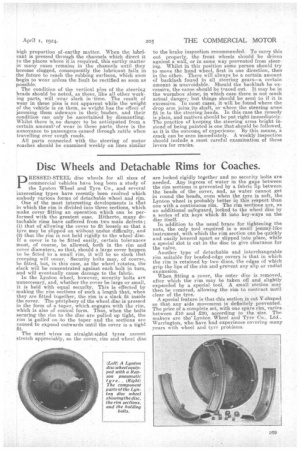Disc Wheels and Detachable Rims for Coaches.
Page 23

If you've noticed an error in this article please click here to report it so we can fix it.
pRESSED-STEEL disc wheels for all sizes of commercial vehicles have long been a study of the Lynton Wheel and Tyre Co., and several interesting types have recently been evolved which embody various forms of detachable 1wheel and rim.
One of the most interesting developments is triat in which the rim is divided into three sections, which make cover fitting an operation which can be performed with the greatest ease. Hitherto, many detachable rims have suffered from two main defects ; (1) that of allowing the cover to fit loosely so that a tyre may be slipped on withoat undue difficulty, and
(2) that the rim is not held rigidly to the wheel disc. If a cover is to be fitted -easily, certain tolerances must, of course, be allowed, both in the rim and cover diameters, so that, should a large cover happen to be fitted to a small rim, it will be so slack that creeping will occur. • Security bolts may, of course, be fitted, but, in this case, as the wheel rotates, the slack will be concentrated against each bolt in turn, and will eventually cause damage -to the fabric.
In the Lynton wheel, however, security bolts are unnecessary, and, whether the cover be large or small, it is held with equal security. This is effected by making the rim sections of such a length that, when they are fitted together, the rim is a slack fit inside the cover. The periphery of the wheel disc is pressed in the form of a taper, which engages with the rim, which is also of conical form. Thus when the bolts securing the rim to the disc are pulled up tight, the rim is pulled on to the taper and the sections are caused to expand outwards until the cover is a tight The steel wires on straight-sided tyres cannot stretch appreciably, so the cover, rim and wheel disc are lacked rigidly together and no security bolts are needed. Any ingress of water in the gaps between the rim sections is prevented by a fabric lip between the beads of the cover, and, as water cannot get in round the beads, even when the tyre is soft, the Lynton wheel is probably better in this respect than one with a continuous rim. The rim sections are as an additional safeguard, locked to the wheel disc by a series of six keys which fit into key-ways on the disc itself.
In addition to the usual brace for tightening the nuts, the only tool required is a small jemmy like instrument, with which the rim section can be quickly and easily levered apart or slipped into place, while a special slot is cut in the disc to give clearance for the valve.
Another type of detachable and interchangeable rim suitable for beaded-edge covers is that in which the rim is retained by two:discs, the edges of which grip the lips of the rim and prevent any slip or radial expansion.
When fitting a cover, the outer disc is removed, after which the rim may be taken off and slightly expanded by a special tool. A small section may then be removed, allowing the rim to contract until clear of the tyre.
A special feature is that .this section is cut V-shaped so that any side Movement is definitely prevented. The price of a complete set, with one spare rim, varies between £10 and £20, according to the size. The makers are the Lynton Wheel and Tyre. Co., Ltd.. Warrington, who have had experience covering many years with wheel and tyre problems.






















































